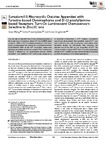Europium(III) Macrocyclic Chelates Appended with Tyrosine-based Chromophores and Di-(2-picolyl)amine-based Receptors: Turn-On Luminescent Chemosensors Selective to Zinc(II) Ions

Use this link to cite
http://hdl.handle.net/2183/25599Collections
- Investigación (FCIE) [1228]
Metadata
Show full item recordTitle
Europium(III) Macrocyclic Chelates Appended with Tyrosine-based Chromophores and Di-(2-picolyl)amine-based Receptors: Turn-On Luminescent Chemosensors Selective to Zinc(II) IonsDate
2020-01-22Citation
G. Wang, C. Platas-Iglesias, G. Angelovski, ChemPlusChem 2020, 85, 806.
Abstract
[Abstract] Zinc ions play an important role in many biological processes in the human body. To selectively detect Zn²⁺, two EuDO3A‐based complexes (DO3A=1,4,7,10‐tetraazacyclododecane‐1,4,7‐tricarboxylic acid) appended with tyrosine as a chromophore and di‐(2‐picolyl)amine (DPA) as the Zn²⁺ recognition moiety were developed as suitable luminescent sensors. Their luminescence intensity is affected by the photoinduced electron transfer mechanism. Upon addition of Zn²⁺, both probes display an up to sevenfold enhancement in Eu³⁺ emission. Competition experiments demonstrated their specificity toward Zn²⁺ over other metal ions, while also revealing the nonspecificity of the derivatives lacking the DPA‐moiety, thus confirming the essential role of the DPA for the recognition of Zn²⁺. The induced emission changes of Eu³⁺ allow for precise quantitative analysis of Zn²⁺, establishing these lanthanide‐based complexes as viable chemosensors for biological applications.
Keywords
Lanthanides
Luminescence
Photoinduced electron transfer
Tyrosine
Zinc
Luminescence
Photoinduced electron transfer
Tyrosine
Zinc
Editor version
Rights
Atribución 4.0 Internacional
ISSN
2192-6506






